-
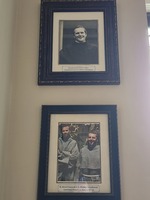 Two photographs at St Thomas of Canterbury
Two photographs at St Thomas of Canterbury This photograph is of a wall in St. Thomas of Canterbury church, a display of two framed photographs. The top one is a black and white photograph of a smiling man wearing the black robe customary of a Franciscan Friar. A small typed label under it reads "Servant of God Casimir Cypher, Conventional Franciscan Martyr of Honduras". The frame surrounding this photograph is black with some white painted decoration around the edges. The bottom photograph is approximately the same size, also in a black frame. This one is in color and depicts the top half of two smiling men in similar uniforms to the above. They are standing in a bright, sunny place in front of some faded green foliage. The caption underneath this photograph reads "Bl. Michal Tomaszek & Bl. Zbigniew Strzalkowski, Conventional Franciscan Martyrs of Peru".
-
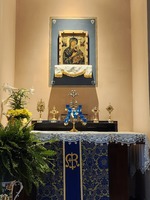 Orthodox-style Icon of Mary and Jesus
Orthodox-style Icon of Mary and Jesus This photograph is of a display at St. Thomas of Canterbury. There is a table with a blue and gold tablecloth and on top of it five gold crosses in a row. In front of the middle one is a display of several small blue glass cups, all of which are empty. The left side of the table is obscured by an offscreen plant display. Above the table is a painting of Mary and baby Jesus in a distinctly Orthodox style. Mary and Jesus are both wearing crowns and flanked by small angels on either side. Next to Jesus is the letters "IC XC", a Greek notation for Jesus Christ. Next to Mary is the letters "MP OY", a Greek notation for Mother of God. This artwork is inlaid in a wooden frame and mounted on a shelf protruding from the wall, which is covered in a small white fabric with gold edges. Surrounding the whole thing is a large blue painted square, with small painted shields on each corner.
-
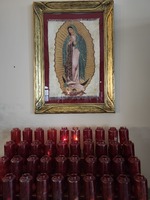 Icon of Mary with candles
Icon of Mary with candles This is a photograph taken of a display in St. Thomas of Canterbury. There is an artwork of Mary and Jesus in a frame and underneath it an array of electric candles for people to 'light', of which some are on. The artwork is a piece of textile art in a Latin American style. In it, Mary is wearing a blue shawl with gold stars on it over a pink robe. She is praying and her eyes are closed. Underneath Mary is baby Jesus, wearing magenta. His arms are outstretched and he has a joyful expression. Only the top half of him is visible because the artwork is cut off by a few inches of fringe or unraveling thread on the top and bottom. Surrounding both Mary and Jesus is a two-toned gold halo, and behind them is a white background of the fabric on which the artwork was made.
-
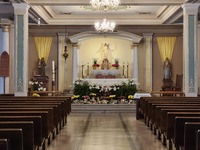 Interiors of St. Thomas of Canterbury
Interiors of St. Thomas of Canterbury These are two pictures of the interior of St. Thomas of Canterbury. The first is a picture of the altar decorated for Easter, with plants like Easter lilies spread out around it. The altar is empty with a white tablecloth on it with gold decorations. Behind it is a gold pyx, or communion box, flanked on either side with a little flower arrangement. Behind the pyx is a statue of Jesus on a pedestal, holding a cross draped with a white fabric. Encircling the altars is several white and gold pillars, holding up an arch partially obscured by a lit chandelier. On the white arch is the sentence "Sanctus Sanctus Sanctus" in gold with decorative crosses on either side. The second picture shows the pews, which are dark brown wood, and part of the ceiling, which is made up of several large square tiles held up by blue, white, and gold pillars. Some of the ceiling tiles have fans or chandeliers hanging from them.
-
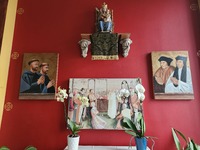 Religious Icons in St. Thomas of Canterbury
Religious Icons in St. Thomas of Canterbury This is a set of 3 images of a wall in St Thomas of Canterbury and the artworks on it. The first is the wall in full, with four distinct artworks. On top is a statue of Mary and baby Jesus, both sitting on a throne and wearing crowns. Jesus is also holding a bible and Mary is holding a flower. Below that statue to the left and right are paintings of saints praying. They are each labeled in their Latin names. On the left is "Sanct Ioann Wall" (Saint John Wall) and "Sanct Ioann Iones" (Saint John Jones). On the right is "Sanct Thom More" (Saint Thomas More) and "Sanct Ioann Fisher" (Saint John Fisher). These two artworks are shown in detail in the second and third images. Beneath both of them in the middle is a painting of a religious service with several people in prayer and priests. In front of that painting is two white orchids.
-
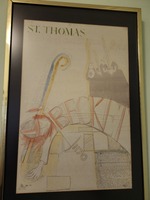 St. Thomas Beckett
St. Thomas Beckett This is a picture of a colored pencil drawing taken from a room in the rectory of St. Thomas of Canterbury. In it, St. Thomas is laying on the ground with a broken and bloodstained sword on his neck, representing his martyrdom. Instead of a body is a stylized version of the name Beckett in all red, which is another name for this saint. To the top left of him is the name St. Thomas and to the top right is a crowd of people with weapons. In the bottom right is a short bit of notation, reading "61/72, JAZ, 70". Around St. Thomas in faint text is a quote near his head with blood spilling onto it. It reads "I give my life to the law of God above the law of man those who do not the same how should they know what I do? How should you know what I do?" and an attribution to T.S. Eliot's "Murder in the Cathedral"
-
 Martyrdom of St. Thomas of Canterbury
Martyrdom of St. Thomas of Canterbury This is an image in St. Thomas of Canterbury depicting the namesake saint's murder. In it, St. Thomas is praying with the top of his head cut off by the threatening soldiers around him, and his mitre and part of his head is bleeding out on the ground. Above the artwork is a plaque reading "Martyrdom of St. Thomas of Canterbury, In Memory of Delia Pluemer, Dedicated November 29, 2009"
-
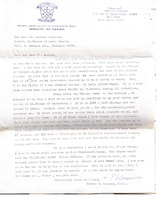 St. Thomas Letter
St. Thomas Letter This letter is to Father Michael Rochford from Bishop Clemens. The letter details the history of himself with the Church, and his connection to Chicago and St. Thomas. He speaks about how he lived in Chicago and served the Church under Father William Rogers. He talks about how his new mission in India is to spread Catholicism in the underdeveloped area. He was requesting funding for this project if there were any willing donors. This letter is significant in a couple of ways, as it shows that the church sticks with people in many ways, as this letter was written in 1981, and Bishop Clemens left the church in 1964 to move back to India. It also highlights the diversity that comes with St Thomas, as it being such a diverse Church they were able to have people from Asia and every corner of the world in their community.
-
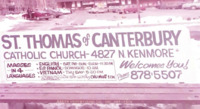 St Thomas Bus Stop Advertisement
St Thomas Bus Stop Advertisement This photo is a bus stop advertisement, taken sometime in the early 1980's, advertising the Church. The bus stop ad has the address, phone number, mass times, and the services that it offers. This photo highlights the diversity that is present within the community of the church. This is shown by the tagline "Mass in 4 languages" and showing the different times in the different languages for mass. The different cultures present in the Uptown area were not only acknowledged but celebrated, and much of the church revolved around how diverse the Church was: it was a place where everyone was welcome and no one was turned away.
-
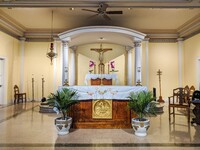 St Thomas Pulpit
St Thomas Pulpit
-
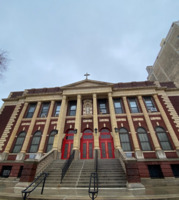 St Thomas Exterior
St Thomas Exterior
-
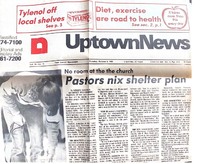 St. Thomas Uptown News clipping
St. Thomas Uptown News clipping This is a newspaper clipping from the 1980s, discussing some of the financial strains that St Thomas was put in during their time in the church. During this period the soup kitchen was vital for the poorer members of Uptown. Financial struggles led to cutting back on projects like a winter shelter for vagrants, previously hosted in 1981. Rev. William Johnson, passionate about the project, felt the city was shirking responsibility, leaving it to churches. He saw it as a broader social issue beyond just Uptown, Edgewater, and Rogers Park. Johnson advocated for collaboration with other churches or neighborhood organizations, rather than tackling it alone.
-
 Palm Sunday Newsletter
Palm Sunday Newsletter
-
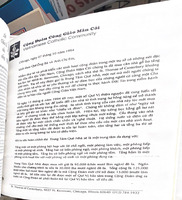 St. Thomas Vietnamese Newsletter
St. Thomas Vietnamese Newsletter
-
 St. Thomas Marriage Certificate
St. Thomas Marriage Certificate
-
 St. Thomas Spanish Newsletter
St. Thomas Spanish Newsletter This is a newsletter found among other Spanish documents at the St. Thomas of Canterbury Rectury in a box labeled “Vietnam.” The writer, Father Alejandro López, writes to the church’s Spanish community in the hopeful spirit of Lent and Easter. He focuses the newsletter with a discussion about God and His gift of “salvation,” which God invites all of His Creation to accept. This, Father López writes, is part of God’s divine plan—that God in His goodness will always win, and that He invites everyone to rejoice in that promise.
-
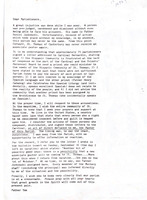 St. Thomas Prejudice
St. Thomas Prejudice This was a newsletter found at the St. Thomas of Canterbury Rectory that was sent out to all of the parishioners of the church. Father Tom, the Pastor at the time, was writing to inform the parishioners of a recent event that had taken place. In this letter Father Tom explains the “great injustice” that was done against the associate pastor Father Daniel Jankowski, where he was wrongly accused and condemned. With this, Father Tom also explains how 75 parishioners wrote to Cardinal Bernardin about injustices facing the Hispanic Community within the church, while he was away. Father Tom wrote this newsletter to warn the parishioners to not go behind his back again, since they did so without permission.
-
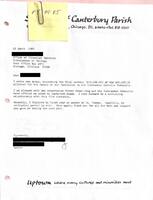 St. Thomas Financial Record
St. Thomas Financial Record A letter detailing the financial situation of St. Thomas of Canterbury. It describes the rental of a space for the Vietnamese community by Father Hung. Father Hung was part of the three-man team that led St. Thomas in the 70s and 80s. He coordinated with others to prepare a space for them and offered them Mass in Vietnamese. At the time of writing this letter he would have been finishing up his first year at St. Thomas.
-
 St. Thomas Color
St. Thomas Color This was a 2005 image found at the St. Thomas of Canterbury Rectory, stored in a box labeled “Vietnam.” Little is known about this picture, but what can be inferred is that it shows a meeting of different cultures and people. The individuals within this image are shown holding different flags, representing different countries coming together outside of the church.
-
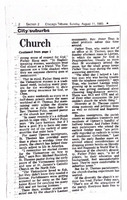 St. Thomas News clipping
St. Thomas News clipping This is a newspaper clipping that was found at the St. Thomas of Canterbury Rectory. The writer describes the spiritual differences between the diverse ethnic groups that make up St. Thomas of Canterbury—namely the “English-speaking,” Vietnamese, and Laotian. In addition, they explain how the church allows not only a place of worship but a neighborly refuge for immigrants. Ultimately, the writer asserts that St. Thomas Church allows the two groups to unite their religious views and build a sense of community.
-
 St. Thomas 65th Anniversary
St. Thomas 65th Anniversary
-
 Mary Mother of God Current Newsletter
Mary Mother of God Current Newsletter A snippet of a current Newsletter found in the St. Thomas church vestibule. It carries the Mary, Mother of God title and contains Mass Times, Office Hours, and other miscellaneous information a parishioner might need.
-
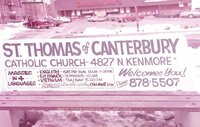 St. Thomas Bench Ad
St. Thomas Bench Ad
-
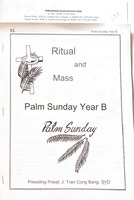 St. Thomas Palm Sunday Newsletter
St. Thomas Palm Sunday Newsletter
-
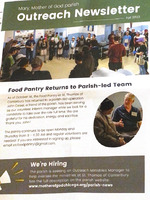 St. Thomas Pantry Newsletter
St. Thomas Pantry Newsletter The front cover of the St. Thomas of Canterbury Food Pantry located in the basement of the church in Uptown. The Pantry has operated since at least 1971 and is the largest food bank in the Chicagoland Area. It was founded by a Catholic Worker House member named Jim Eber
 Two photographs at St Thomas of Canterbury This photograph is of a wall in St. Thomas of Canterbury church, a display of two framed photographs. The top one is a black and white photograph of a smiling man wearing the black robe customary of a Franciscan Friar. A small typed label under it reads "Servant of God Casimir Cypher, Conventional Franciscan Martyr of Honduras". The frame surrounding this photograph is black with some white painted decoration around the edges. The bottom photograph is approximately the same size, also in a black frame. This one is in color and depicts the top half of two smiling men in similar uniforms to the above. They are standing in a bright, sunny place in front of some faded green foliage. The caption underneath this photograph reads "Bl. Michal Tomaszek & Bl. Zbigniew Strzalkowski, Conventional Franciscan Martyrs of Peru".
Two photographs at St Thomas of Canterbury This photograph is of a wall in St. Thomas of Canterbury church, a display of two framed photographs. The top one is a black and white photograph of a smiling man wearing the black robe customary of a Franciscan Friar. A small typed label under it reads "Servant of God Casimir Cypher, Conventional Franciscan Martyr of Honduras". The frame surrounding this photograph is black with some white painted decoration around the edges. The bottom photograph is approximately the same size, also in a black frame. This one is in color and depicts the top half of two smiling men in similar uniforms to the above. They are standing in a bright, sunny place in front of some faded green foliage. The caption underneath this photograph reads "Bl. Michal Tomaszek & Bl. Zbigniew Strzalkowski, Conventional Franciscan Martyrs of Peru". Orthodox-style Icon of Mary and Jesus This photograph is of a display at St. Thomas of Canterbury. There is a table with a blue and gold tablecloth and on top of it five gold crosses in a row. In front of the middle one is a display of several small blue glass cups, all of which are empty. The left side of the table is obscured by an offscreen plant display. Above the table is a painting of Mary and baby Jesus in a distinctly Orthodox style. Mary and Jesus are both wearing crowns and flanked by small angels on either side. Next to Jesus is the letters "IC XC", a Greek notation for Jesus Christ. Next to Mary is the letters "MP OY", a Greek notation for Mother of God. This artwork is inlaid in a wooden frame and mounted on a shelf protruding from the wall, which is covered in a small white fabric with gold edges. Surrounding the whole thing is a large blue painted square, with small painted shields on each corner.
Orthodox-style Icon of Mary and Jesus This photograph is of a display at St. Thomas of Canterbury. There is a table with a blue and gold tablecloth and on top of it five gold crosses in a row. In front of the middle one is a display of several small blue glass cups, all of which are empty. The left side of the table is obscured by an offscreen plant display. Above the table is a painting of Mary and baby Jesus in a distinctly Orthodox style. Mary and Jesus are both wearing crowns and flanked by small angels on either side. Next to Jesus is the letters "IC XC", a Greek notation for Jesus Christ. Next to Mary is the letters "MP OY", a Greek notation for Mother of God. This artwork is inlaid in a wooden frame and mounted on a shelf protruding from the wall, which is covered in a small white fabric with gold edges. Surrounding the whole thing is a large blue painted square, with small painted shields on each corner. Icon of Mary with candles This is a photograph taken of a display in St. Thomas of Canterbury. There is an artwork of Mary and Jesus in a frame and underneath it an array of electric candles for people to 'light', of which some are on. The artwork is a piece of textile art in a Latin American style. In it, Mary is wearing a blue shawl with gold stars on it over a pink robe. She is praying and her eyes are closed. Underneath Mary is baby Jesus, wearing magenta. His arms are outstretched and he has a joyful expression. Only the top half of him is visible because the artwork is cut off by a few inches of fringe or unraveling thread on the top and bottom. Surrounding both Mary and Jesus is a two-toned gold halo, and behind them is a white background of the fabric on which the artwork was made.
Icon of Mary with candles This is a photograph taken of a display in St. Thomas of Canterbury. There is an artwork of Mary and Jesus in a frame and underneath it an array of electric candles for people to 'light', of which some are on. The artwork is a piece of textile art in a Latin American style. In it, Mary is wearing a blue shawl with gold stars on it over a pink robe. She is praying and her eyes are closed. Underneath Mary is baby Jesus, wearing magenta. His arms are outstretched and he has a joyful expression. Only the top half of him is visible because the artwork is cut off by a few inches of fringe or unraveling thread on the top and bottom. Surrounding both Mary and Jesus is a two-toned gold halo, and behind them is a white background of the fabric on which the artwork was made. Interiors of St. Thomas of Canterbury These are two pictures of the interior of St. Thomas of Canterbury. The first is a picture of the altar decorated for Easter, with plants like Easter lilies spread out around it. The altar is empty with a white tablecloth on it with gold decorations. Behind it is a gold pyx, or communion box, flanked on either side with a little flower arrangement. Behind the pyx is a statue of Jesus on a pedestal, holding a cross draped with a white fabric. Encircling the altars is several white and gold pillars, holding up an arch partially obscured by a lit chandelier. On the white arch is the sentence "Sanctus Sanctus Sanctus" in gold with decorative crosses on either side. The second picture shows the pews, which are dark brown wood, and part of the ceiling, which is made up of several large square tiles held up by blue, white, and gold pillars. Some of the ceiling tiles have fans or chandeliers hanging from them.
Interiors of St. Thomas of Canterbury These are two pictures of the interior of St. Thomas of Canterbury. The first is a picture of the altar decorated for Easter, with plants like Easter lilies spread out around it. The altar is empty with a white tablecloth on it with gold decorations. Behind it is a gold pyx, or communion box, flanked on either side with a little flower arrangement. Behind the pyx is a statue of Jesus on a pedestal, holding a cross draped with a white fabric. Encircling the altars is several white and gold pillars, holding up an arch partially obscured by a lit chandelier. On the white arch is the sentence "Sanctus Sanctus Sanctus" in gold with decorative crosses on either side. The second picture shows the pews, which are dark brown wood, and part of the ceiling, which is made up of several large square tiles held up by blue, white, and gold pillars. Some of the ceiling tiles have fans or chandeliers hanging from them. Religious Icons in St. Thomas of Canterbury This is a set of 3 images of a wall in St Thomas of Canterbury and the artworks on it. The first is the wall in full, with four distinct artworks. On top is a statue of Mary and baby Jesus, both sitting on a throne and wearing crowns. Jesus is also holding a bible and Mary is holding a flower. Below that statue to the left and right are paintings of saints praying. They are each labeled in their Latin names. On the left is "Sanct Ioann Wall" (Saint John Wall) and "Sanct Ioann Iones" (Saint John Jones). On the right is "Sanct Thom More" (Saint Thomas More) and "Sanct Ioann Fisher" (Saint John Fisher). These two artworks are shown in detail in the second and third images. Beneath both of them in the middle is a painting of a religious service with several people in prayer and priests. In front of that painting is two white orchids.
Religious Icons in St. Thomas of Canterbury This is a set of 3 images of a wall in St Thomas of Canterbury and the artworks on it. The first is the wall in full, with four distinct artworks. On top is a statue of Mary and baby Jesus, both sitting on a throne and wearing crowns. Jesus is also holding a bible and Mary is holding a flower. Below that statue to the left and right are paintings of saints praying. They are each labeled in their Latin names. On the left is "Sanct Ioann Wall" (Saint John Wall) and "Sanct Ioann Iones" (Saint John Jones). On the right is "Sanct Thom More" (Saint Thomas More) and "Sanct Ioann Fisher" (Saint John Fisher). These two artworks are shown in detail in the second and third images. Beneath both of them in the middle is a painting of a religious service with several people in prayer and priests. In front of that painting is two white orchids. St. Thomas Beckett This is a picture of a colored pencil drawing taken from a room in the rectory of St. Thomas of Canterbury. In it, St. Thomas is laying on the ground with a broken and bloodstained sword on his neck, representing his martyrdom. Instead of a body is a stylized version of the name Beckett in all red, which is another name for this saint. To the top left of him is the name St. Thomas and to the top right is a crowd of people with weapons. In the bottom right is a short bit of notation, reading "61/72, JAZ, 70". Around St. Thomas in faint text is a quote near his head with blood spilling onto it. It reads "I give my life to the law of God above the law of man those who do not the same how should they know what I do? How should you know what I do?" and an attribution to T.S. Eliot's "Murder in the Cathedral"
St. Thomas Beckett This is a picture of a colored pencil drawing taken from a room in the rectory of St. Thomas of Canterbury. In it, St. Thomas is laying on the ground with a broken and bloodstained sword on his neck, representing his martyrdom. Instead of a body is a stylized version of the name Beckett in all red, which is another name for this saint. To the top left of him is the name St. Thomas and to the top right is a crowd of people with weapons. In the bottom right is a short bit of notation, reading "61/72, JAZ, 70". Around St. Thomas in faint text is a quote near his head with blood spilling onto it. It reads "I give my life to the law of God above the law of man those who do not the same how should they know what I do? How should you know what I do?" and an attribution to T.S. Eliot's "Murder in the Cathedral" Martyrdom of St. Thomas of Canterbury This is an image in St. Thomas of Canterbury depicting the namesake saint's murder. In it, St. Thomas is praying with the top of his head cut off by the threatening soldiers around him, and his mitre and part of his head is bleeding out on the ground. Above the artwork is a plaque reading "Martyrdom of St. Thomas of Canterbury, In Memory of Delia Pluemer, Dedicated November 29, 2009"
Martyrdom of St. Thomas of Canterbury This is an image in St. Thomas of Canterbury depicting the namesake saint's murder. In it, St. Thomas is praying with the top of his head cut off by the threatening soldiers around him, and his mitre and part of his head is bleeding out on the ground. Above the artwork is a plaque reading "Martyrdom of St. Thomas of Canterbury, In Memory of Delia Pluemer, Dedicated November 29, 2009" St. Thomas Letter This letter is to Father Michael Rochford from Bishop Clemens. The letter details the history of himself with the Church, and his connection to Chicago and St. Thomas. He speaks about how he lived in Chicago and served the Church under Father William Rogers. He talks about how his new mission in India is to spread Catholicism in the underdeveloped area. He was requesting funding for this project if there were any willing donors. This letter is significant in a couple of ways, as it shows that the church sticks with people in many ways, as this letter was written in 1981, and Bishop Clemens left the church in 1964 to move back to India. It also highlights the diversity that comes with St Thomas, as it being such a diverse Church they were able to have people from Asia and every corner of the world in their community.
St. Thomas Letter This letter is to Father Michael Rochford from Bishop Clemens. The letter details the history of himself with the Church, and his connection to Chicago and St. Thomas. He speaks about how he lived in Chicago and served the Church under Father William Rogers. He talks about how his new mission in India is to spread Catholicism in the underdeveloped area. He was requesting funding for this project if there were any willing donors. This letter is significant in a couple of ways, as it shows that the church sticks with people in many ways, as this letter was written in 1981, and Bishop Clemens left the church in 1964 to move back to India. It also highlights the diversity that comes with St Thomas, as it being such a diverse Church they were able to have people from Asia and every corner of the world in their community. St Thomas Bus Stop Advertisement This photo is a bus stop advertisement, taken sometime in the early 1980's, advertising the Church. The bus stop ad has the address, phone number, mass times, and the services that it offers. This photo highlights the diversity that is present within the community of the church. This is shown by the tagline "Mass in 4 languages" and showing the different times in the different languages for mass. The different cultures present in the Uptown area were not only acknowledged but celebrated, and much of the church revolved around how diverse the Church was: it was a place where everyone was welcome and no one was turned away.
St Thomas Bus Stop Advertisement This photo is a bus stop advertisement, taken sometime in the early 1980's, advertising the Church. The bus stop ad has the address, phone number, mass times, and the services that it offers. This photo highlights the diversity that is present within the community of the church. This is shown by the tagline "Mass in 4 languages" and showing the different times in the different languages for mass. The different cultures present in the Uptown area were not only acknowledged but celebrated, and much of the church revolved around how diverse the Church was: it was a place where everyone was welcome and no one was turned away. St Thomas Pulpit
St Thomas Pulpit  St Thomas Exterior
St Thomas Exterior  St. Thomas Uptown News clipping This is a newspaper clipping from the 1980s, discussing some of the financial strains that St Thomas was put in during their time in the church. During this period the soup kitchen was vital for the poorer members of Uptown. Financial struggles led to cutting back on projects like a winter shelter for vagrants, previously hosted in 1981. Rev. William Johnson, passionate about the project, felt the city was shirking responsibility, leaving it to churches. He saw it as a broader social issue beyond just Uptown, Edgewater, and Rogers Park. Johnson advocated for collaboration with other churches or neighborhood organizations, rather than tackling it alone.
St. Thomas Uptown News clipping This is a newspaper clipping from the 1980s, discussing some of the financial strains that St Thomas was put in during their time in the church. During this period the soup kitchen was vital for the poorer members of Uptown. Financial struggles led to cutting back on projects like a winter shelter for vagrants, previously hosted in 1981. Rev. William Johnson, passionate about the project, felt the city was shirking responsibility, leaving it to churches. He saw it as a broader social issue beyond just Uptown, Edgewater, and Rogers Park. Johnson advocated for collaboration with other churches or neighborhood organizations, rather than tackling it alone. Palm Sunday Newsletter
Palm Sunday Newsletter  St. Thomas Vietnamese Newsletter
St. Thomas Vietnamese Newsletter  St. Thomas Marriage Certificate
St. Thomas Marriage Certificate  St. Thomas Spanish Newsletter This is a newsletter found among other Spanish documents at the St. Thomas of Canterbury Rectury in a box labeled “Vietnam.” The writer, Father Alejandro López, writes to the church’s Spanish community in the hopeful spirit of Lent and Easter. He focuses the newsletter with a discussion about God and His gift of “salvation,” which God invites all of His Creation to accept. This, Father López writes, is part of God’s divine plan—that God in His goodness will always win, and that He invites everyone to rejoice in that promise.
St. Thomas Spanish Newsletter This is a newsletter found among other Spanish documents at the St. Thomas of Canterbury Rectury in a box labeled “Vietnam.” The writer, Father Alejandro López, writes to the church’s Spanish community in the hopeful spirit of Lent and Easter. He focuses the newsletter with a discussion about God and His gift of “salvation,” which God invites all of His Creation to accept. This, Father López writes, is part of God’s divine plan—that God in His goodness will always win, and that He invites everyone to rejoice in that promise. St. Thomas Prejudice This was a newsletter found at the St. Thomas of Canterbury Rectory that was sent out to all of the parishioners of the church. Father Tom, the Pastor at the time, was writing to inform the parishioners of a recent event that had taken place. In this letter Father Tom explains the “great injustice” that was done against the associate pastor Father Daniel Jankowski, where he was wrongly accused and condemned. With this, Father Tom also explains how 75 parishioners wrote to Cardinal Bernardin about injustices facing the Hispanic Community within the church, while he was away. Father Tom wrote this newsletter to warn the parishioners to not go behind his back again, since they did so without permission.
St. Thomas Prejudice This was a newsletter found at the St. Thomas of Canterbury Rectory that was sent out to all of the parishioners of the church. Father Tom, the Pastor at the time, was writing to inform the parishioners of a recent event that had taken place. In this letter Father Tom explains the “great injustice” that was done against the associate pastor Father Daniel Jankowski, where he was wrongly accused and condemned. With this, Father Tom also explains how 75 parishioners wrote to Cardinal Bernardin about injustices facing the Hispanic Community within the church, while he was away. Father Tom wrote this newsletter to warn the parishioners to not go behind his back again, since they did so without permission. St. Thomas Financial Record A letter detailing the financial situation of St. Thomas of Canterbury. It describes the rental of a space for the Vietnamese community by Father Hung. Father Hung was part of the three-man team that led St. Thomas in the 70s and 80s. He coordinated with others to prepare a space for them and offered them Mass in Vietnamese. At the time of writing this letter he would have been finishing up his first year at St. Thomas.
St. Thomas Financial Record A letter detailing the financial situation of St. Thomas of Canterbury. It describes the rental of a space for the Vietnamese community by Father Hung. Father Hung was part of the three-man team that led St. Thomas in the 70s and 80s. He coordinated with others to prepare a space for them and offered them Mass in Vietnamese. At the time of writing this letter he would have been finishing up his first year at St. Thomas. St. Thomas Color This was a 2005 image found at the St. Thomas of Canterbury Rectory, stored in a box labeled “Vietnam.” Little is known about this picture, but what can be inferred is that it shows a meeting of different cultures and people. The individuals within this image are shown holding different flags, representing different countries coming together outside of the church.
St. Thomas Color This was a 2005 image found at the St. Thomas of Canterbury Rectory, stored in a box labeled “Vietnam.” Little is known about this picture, but what can be inferred is that it shows a meeting of different cultures and people. The individuals within this image are shown holding different flags, representing different countries coming together outside of the church. St. Thomas News clipping This is a newspaper clipping that was found at the St. Thomas of Canterbury Rectory. The writer describes the spiritual differences between the diverse ethnic groups that make up St. Thomas of Canterbury—namely the “English-speaking,” Vietnamese, and Laotian. In addition, they explain how the church allows not only a place of worship but a neighborly refuge for immigrants. Ultimately, the writer asserts that St. Thomas Church allows the two groups to unite their religious views and build a sense of community.
St. Thomas News clipping This is a newspaper clipping that was found at the St. Thomas of Canterbury Rectory. The writer describes the spiritual differences between the diverse ethnic groups that make up St. Thomas of Canterbury—namely the “English-speaking,” Vietnamese, and Laotian. In addition, they explain how the church allows not only a place of worship but a neighborly refuge for immigrants. Ultimately, the writer asserts that St. Thomas Church allows the two groups to unite their religious views and build a sense of community. St. Thomas 65th Anniversary
St. Thomas 65th Anniversary  Mary Mother of God Current Newsletter A snippet of a current Newsletter found in the St. Thomas church vestibule. It carries the Mary, Mother of God title and contains Mass Times, Office Hours, and other miscellaneous information a parishioner might need.
Mary Mother of God Current Newsletter A snippet of a current Newsletter found in the St. Thomas church vestibule. It carries the Mary, Mother of God title and contains Mass Times, Office Hours, and other miscellaneous information a parishioner might need. St. Thomas Bench Ad
St. Thomas Bench Ad  St. Thomas Palm Sunday Newsletter
St. Thomas Palm Sunday Newsletter  St. Thomas Pantry Newsletter The front cover of the St. Thomas of Canterbury Food Pantry located in the basement of the church in Uptown. The Pantry has operated since at least 1971 and is the largest food bank in the Chicagoland Area. It was founded by a Catholic Worker House member named Jim Eber
St. Thomas Pantry Newsletter The front cover of the St. Thomas of Canterbury Food Pantry located in the basement of the church in Uptown. The Pantry has operated since at least 1971 and is the largest food bank in the Chicagoland Area. It was founded by a Catholic Worker House member named Jim Eber